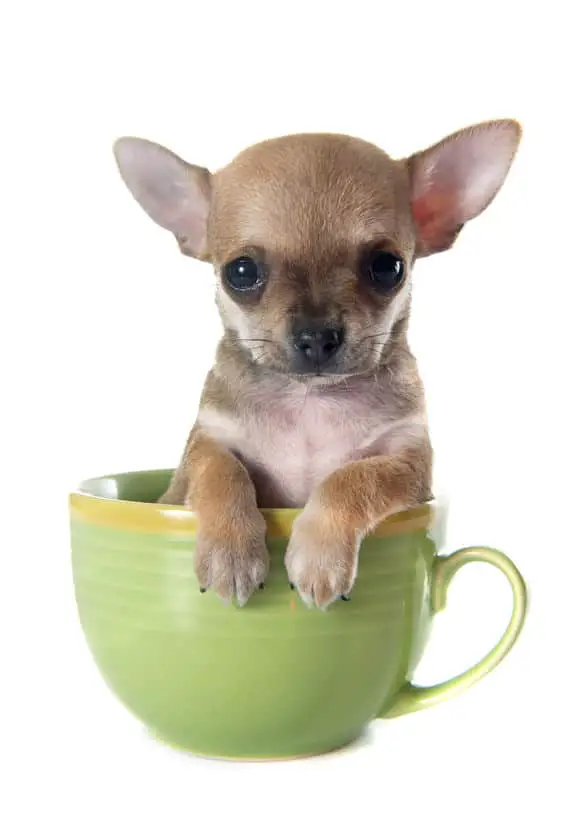Whether you currently own one or thinking about it, there are many misconceptions about teacup Chihuahuas.
The most common one being that this is a new dog breed, which isn’t the case. And according to the American Kennel Club (AKC), Chihuahuas only exist in two varieties i.e., the long-coat and the smooth.
So, why do people refer to these smaller varieties of Chihuahuas as teacups?
The answers vary accordingly, with the most apparent one being that most of them can fit inside a teacup.
Besides that, most breeders of the smaller Chihuahua variety promote this reference to make them seem more attractive.
Here, we look at the facts about the teacup Chihuahuas to help you understand what you currently don’t know about them.
If you own one, knowing more about them ensures that you have valuable information on how to take care of your pooch.
Otherwise, getting more informed on this tiny dog will give you a clear direction on whether it’s the right pet in your home or not.
Are Teacup Chihuahuas real?
Yes, they are. Teacup Chihuahuas have been in existence for approximately a decade now, and this came about from breeders selecting smaller dogs to breed with the Chihuahuas.
Their sizeable nature makes them look cute and adorable, but mostly bear several health issues.
Let’s take a look at a brief history of the Chihuahua dog breed.
Chihuahua originates from an area in Mexico, this isn’t necessarily where Chihuahuas came from. While there are still some debates on this dog’s origin, one thing remains unchanged; teacup Chihuahuas are real and they are not a new breed.
From factual history, the Toltec civilization responsible for dominating Mexico over 1000 years bred an enormous Chihuahua variety.
This version was called the Techichi and was later refined to a smaller and lighter version by the Aztecs.
After the Spanish conquistador’s invasion, this breed survived and was discovered by American explorers in the 1800s.
The explorers named them after where they first found them, hence the name Chihuahua.
Afterward, the American Kennel Club registered the first Chihuahua in 1908. However, its popularity surged between the 1940s and 1950s and has since been among the most preferred dog breeds in the country.

Shows such as Beverly Hills Chihuahua, among others, made this breed even more popular and desirable by many people.
Therefore, Chihuahuas go way back in time compared to this new variety of teacups.
The latter isn’t that old since it was first discovered but has managed to interest many people’s attention.
Currently, this variety of Chihuahua ranks top among litters that are least healthy from birth.
So, before picking one to be your pet, ascertain if you can adequately sustain the pros and cons.
How big do they get?
There isn’t a standard size for teacup Chihuahuas, and their size can vary depending on the breeders’ breeding selections.
However, some aspects such as weight and height can be a standard way of determining the size of this breed version.
For starters, most teacup Chihuahuas can only weigh up to 4 pounds. Although some can weigh over 5 pounds, the former is usually the most common outcome.
When it comes to height, the Teacup Chihuahua breed version reaches a maximum of 6 inches only.
However, this isn’t the actual classification of their height because some even get shorter or taller than this.
Some can fit inside a teacup while others don’t, which shows that this version of Chihuahuas doesn’t have standard body size specifications.
Chihuahuas can take 8 months to a full year to fully mature. However, smaller versions are discovered if they don’t grow bigger or taller than the sizes mentioned above.
When such happens, the dog might look like a pup their whole life.
The name teacup Chihuahuas mostly originates from business-savvy breeders intending to make this version more attractive, and eventually expensive.
For how big a Chihuahua can get, there isn’t any universally standard consensus.
What is the difference between a Teacup and a Regular (Toy) Chihuahua?
Like mentioned earlier, teacup Chihuahuas aren’t your typical Chihuahuas.
They are tiny from their weight to height, which isn’t the case with a standard Chihuahua.
These can grow to consensual heights of up to 10 inches and weigh over 6 pounds when catered for accordingly.
Although small, teacup Chihuahuas can be very vicious and are mostly characterized by having short tempers.
For this reason, they are mostly regarded as a more aggressive version of the Chihuahuas. This makes them less desirable to some people, especially those with younger children in their homes.
Due to their size, this version of Chihuahuas attracts multiple health concerns.

Therefore, caring for teacups needs more effort and caution compared to the standard Chihuahuas.
This means you have to employ extra emphasis on their care if you have one or prepare to do so if you think about owning one.
How much do they cost?
Although you might be taking home one of the smallest dogs in the litter, this version of Chihuahuas is big.
Breeders benefit the most from this transaction, which is why they emphasize on popularizing this version.
Even though they know this isn’t a new different breed, most breeders don’t necessarily correct unaware customers.
Teacup Chihuahuas prices can range from $1000 onwards, depending on the breeder’s specifications. Surprisingly, some buyers have paid breeders more than $10, 000 to acquire a teacup Chihuahua pup.
Remember, these are just estimations, meaning that buyers of this smaller Chihuahua version might be paying even more of the approximately quoted prices.
But the astonishing expenses come after bringing your pooch home. They require a specialized diet and should be fed adhering to advised timelines.
This is to avoid stressing their bowels from too much food or keeping them too hungry. So, if you are away from home due to work, you must assign a doggy daycare for your pup.
This is to ensure all your dog’s needs are met to keep their health as optimal as possible.
And due to their sizes, teacup Chihuahuas develop many health issues as they grow up. So, expect regular vet visits, which is another wallet denting activity. Therefore, you have to factor in pet insurance in your budget.
How much exercise do they require?
Because such tiny dogs can only move around in little spaces, they only require minimal exercises.
This is to stimulate and amuse them while minimizing their chances of getting injured.
Teacup Chihuahuas are very fragile and can develop fractures from jumping off the sofa.
You shouldn’t be aggressive when playing with them because you might easily break their fragile bones. Therefore, you should consider their health and tailor exercises according to their needs.
Grooming requirements
Grooming teacup Chihuahuas highly depends on their coat type. If your pooch has a smooth coat, you can occasionally brush it and give it weekly baths.
On the other hand, long-haired teacups need cleaning at least twice every week.
Additionally, there is a need for regular dental checks and nail-trimming to keep your dog clean and healthy.
Health issues
Like standard Chihuahuas, teacup versions of this breed also face similar health problems.
However, the size of the teacup Chihuahuas raises the health issue occurrences and sometimes even worsens them.
This contributes highly to the short lifespan experienced in this version of Chihuahuas.
Here are several common health conditions experienced by teacup Chihuahuas:
• Bladder issues – It can be difficult for them to hold urine due to their small size, which may result in frequent urination.
• Fragile bones – Bone development issues and fractures are mostly the cases with this type of dog caused by their weak bones.
• Patellar luxation – Like in many small dog breeds, kneecap dislocation is common in teacup Chihuahuas.
• Hypoglycemia – Due to their smallness, teacup Chihuahuas have a higher metabolic rate. This makes them quickly use up their glucose reserves, causing them to have low blood sugar.
• Neurological conditions – Problems such as the syringomyelia, which is the progressive disease of the spinal cord, and spina bifida are pretty common in teacup Chihuahuas.
• Dental issues – Because it has a small jaw, teacup Chihuahuas can easily damage it from just chewing.
• Heart disease – Teacup dogs have increased rates of heart conditions because their hearts weren’t meant to be small. But because of breeding this version, such an organ has been insanely scaled down. With so doing, their hearts quickly fail or break down unexpectedly.
How long do they live?
There are no reliable data for the life expectancy of a teacup Chihuahua, it however revolves around how they are cared for and the conditions around them.
Chihuahuas have a reported life expectancy of between 7 to 12 years. It is expected, with all the necessary precautions and care taken, that the teacup Chihuahua can live up to 7 years.
This is very much at the mercy of the health issues that could possibly plague your teacup Chihuahua.
What do you feed them?
In order to get them healthy, it is necessary to meet their daily nutritional needs with some of the best dog food out there.
Due to the teacup Chihuahua’s health issue and being prone to hypoglycemia, it is important to feed your teacup little portions of food, at least 4 to 6 times a day or as instructed by your vet.
An even mixture of dry, wet, and raw dog food can help keep things interesting while satisfying his/her nutritional requirements.
Avoid feeding your pooch sugary treats to help maintain a good dental condition as well as preventing possible diabetes.
It is important to pay attention to your pooch whenever you are trying out new food, watch out for reactions such as allergies, diarrhea, amongst other signs of discomfort.
Teacup Chihuahuas and Kids
It is not advisable to keep teacup Chihuahuas in homes with little kids. This is simply due to the fragility of these pooches.
As earlier mentioned, the teacup Chihuahua is prone to suffer the development of fragile bone and can easily get fractures amongst other things.
Kids are known to be quite oblivious to this fact and could be too rough with a teacup Chihuahua, leading to possible injuries.
The utmost care is required when dealing with these tiny variants of the Chihuahua dog, something kids aren’t known for.
Do Teacup Chihuahuas get along with other Dogs
The teacup chihuahua can get along just well with other dogs, they still possess the same temperament of the regular Chihuahua.
With proper puppy-stage socialization, the teacup Chihuahua can develop well-balanced confidence around other dogs.
It is important to point out that it is not wise to leave your teacup Chi with very active and overly playful dogs.
This is due to their fragile nature which makes them prone to suffering physical injuries.
Teacup Chihuahuas FAQs
Here are some frequently asked questions about the Teacup Chihuahuas:
What is a teacup Chihuahua?
This is a smaller version of the Chihuahua breed, which usually originates from breeding a standard Chihuahua with a smaller dog breed.
Do teacup Chihuahuas make good pets?
A small and adorable dog that doesn’t take up too much of your space is a viable option for any pet lover.
Teacup Chihuahuas are the ultimate companion dog, always willing to stay next to you or on your laps.
They might require more effort to keep them healthy and safe, but if you are capable of fulfilling these requirements, they will make a great addition to your family.
Conclusion
The teacup Chihuahua is a real variant of the standard Chihuahua and has been around for quite some time now.
Due to their size, they are prone to a slew of health issues and can be quite high maintenance as a result of their fragile nature.
They are not great with kids but can get along with docile and calmer dogs and cats.
They have risen in popularity in recent times and this is largely due to the spotlight being placed on them by people online.

